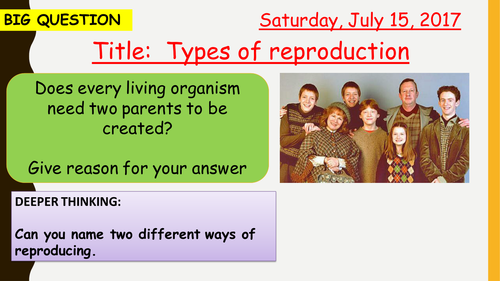
Types of reproduction lesson created in accordance to the NEW AQA Specification (9-1). Designed for a TRILOGY class, although content can be adjusted to suit any ability. Includes: slide animations, embedded videos and practice questions with answers on slides as well as a quiz.
AQA spec link: 6.1.1
Relevant chapter: B12 Genetics and reproduction. AQA Biology third edition textbook-Page 162-163.
Specification requires students to know the following;
Students should understand that meiosis leads to non-identical cells being formed while mitosis leads to identical cells being formed. Sexual reproduction involves the joining (fusion) of male and female gametes:
• sperm and egg cells in animals
• pollen and egg cells in flowering plants.
In sexual reproduction there is mixing of genetic information which leads to variety in the offspring. The formation of gametes involves meiosis. Asexual reproduction involves only one parent and no fusion of gametes. There is no mixing of genetic information. This leads to genetically identical offspring (clones). Only mitosis is involved.
Good luck with your lesson!
AQA spec link: 6.1.1
Relevant chapter: B12 Genetics and reproduction. AQA Biology third edition textbook-Page 162-163.
Specification requires students to know the following;
Students should understand that meiosis leads to non-identical cells being formed while mitosis leads to identical cells being formed. Sexual reproduction involves the joining (fusion) of male and female gametes:
• sperm and egg cells in animals
• pollen and egg cells in flowering plants.
In sexual reproduction there is mixing of genetic information which leads to variety in the offspring. The formation of gametes involves meiosis. Asexual reproduction involves only one parent and no fusion of gametes. There is no mixing of genetic information. This leads to genetically identical offspring (clones). Only mitosis is involved.
Good luck with your lesson!
Get this resource as part of a bundle and save up to 20%
A bundle is a package of resources grouped together to teach a particular topic, or a series of lessons, in one place.
Something went wrong, please try again later.
This resource hasn't been reviewed yet
To ensure quality for our reviews, only customers who have purchased this resource can review it
Report this resourceto let us know if it violates our terms and conditions.
Our customer service team will review your report and will be in touch.
£3.00
